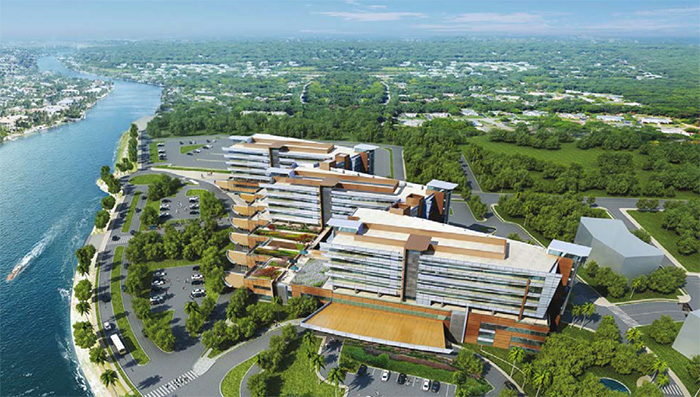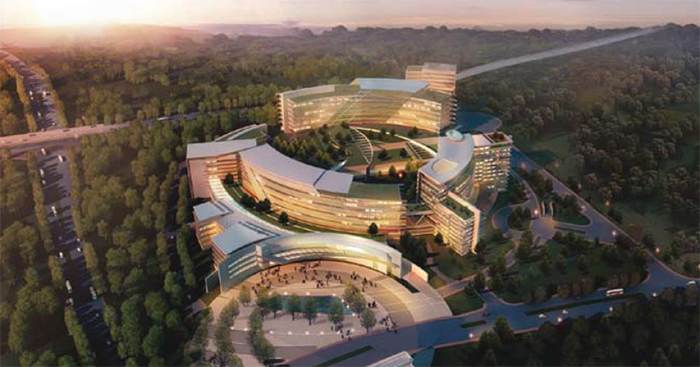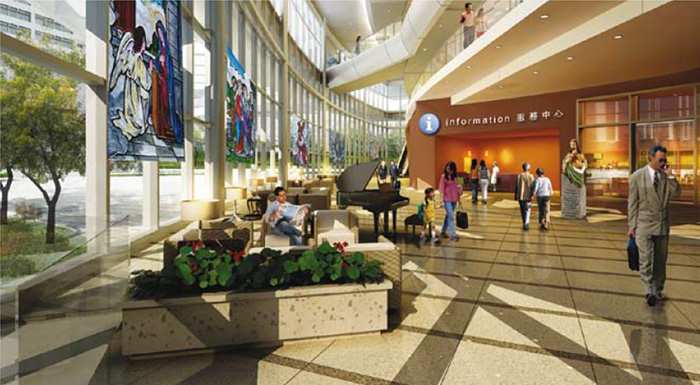This article serves as a catalyst toward recognising some of the basic issues and trends that will be driving the design of health and hospital facilities in Asia, as well as in other regions of the world.
Basic questions such as environmental, physical, mental and spiritual health and wellbeing are often overlooked in the rush to design health and hospital facilities.
Access
If the public cannot reach a healthcare facility because of its location or lack of infrastructure, it might as well not exist. Easy access by foot, bicycle, scooter and motorcycle, public transportation (buses, jitneys, taxis, vans, trains, ambulance), automobile and / or helicopter is vital.

Quality
Once people arrive, there must be a high level of quality and competent care, qualified and available physicians and allied health professionals that are readily available and accessible. Quality care can be measured and compared to national and international norms, average life spans and causes of illness and death.
Alignment of care and expertise
Designing and building health facilities without thoroughly thinking through the patient population and their health problems. the type of allied professionals needed, and the type and scope of health and hospital facilities needed is simply not solving the 'whole' problem
Care providers must develop comprehensive disease-fighting strategies, rather than just constructing new buildings. This requires an understanding of the causes of illness and death in a region of the world and how to prevent, diagnose and treat and rehabilitate people from the effects of these diseases.
Funding, staffing and operating health and hospital facilities
In some parts of the world more competition between health networks effectively lowers costs. In other parts of the world, collaboration and cooperative approaches work better in controlling costs. When designing and building health and hospital facilities one must keep in mind that the life cycle project costs over the years dwarf the original construction costs. In some cases, expensive health and hospital facilities have been built and a country has not budgeted for the operating costs, or coordinated and planned the allied health professionals or the proper staffing requirements.
Facts
Facts are essential for developing appropriate health facilities. There must be a multi-pronged effort of pre-programming, research and discussion to determine the most appropriate planning, programming and design of facilities to treat disease. Health initiatives and health facilities should be designed to prevent illness, detect disease early on, treat and then rehabilitate the population.
Demographics
Trends in demographic facts and the life expectancy of population sectors have to be determined. Some regional populations are growing at an accelerating rate, while others have a significant aged population and fewer births.
Understanding the causes of and prevention of illness and death
Different parts of the world face diverse threats to human existence, ranging from water-borne diseases to malaria and chronic diseases; each cause of illness and death requires a unique prevention and treatment approach. Many diseases can be prevented by undertaking proper and appropriate education and environmental measures. Numerous areas of the world have built an excellent system of curative care, but much more must be done to create an equally excellent system of preventive care. Health education in the home, community at large and particularly in the school systems is vital.
The home and family structure
A strong family structure has implications in health education and home care as well as in the design of medical services. The home environment is the most basic and important health facility. There is also the important relationship of health education and school clinics, staffed by qualified allied health professionals. In some parts of the world, entire communities and tribes come to the regional health centre or hospital to visit someone who is ill, for taking care and even cooking for them.

Community
People in the community need to have the knowledge and the incentives for their family and individual to stay healthy. When designing health facilities throughout Asia as well as elsewhere around the world, health facility architects must consider climate, culture, religion, traditions, local economics, level of education and health education and the difference between needs and wants.
Trends
New channels for continuous care
The widely acknowledged focus on disease prevention and wellness continues to be tremendously important. Non-communicable ailments such as heart disease, stroke and chronic respiratory diseases are becoming more prevalent, and chronic diseases continue to account for many healthcare costs. In response to this, forward-thinking healthcare providers are expanding their services beyond the physical walls of hospitals and clinics. With strong informational and educational components, these services include virtual consultations, remote monitoring of vital signs, access to online medical records and targeted community health screening events.
Crafting better-performing facilities through research
More than ever, healthcare designers are responsible for crafting environments that provide quantifiable improvements in organisational effectiveness and patient outcomes and satisfaction. A cornerstone of this practice is evidence-based design, characterised by the use and generation of scientific evidence in order to support decision-making for more predictable outcomes. This framework is used to systematically analyse the outcomes of particular types of designs for areas such as patient rooms, nurse stations and surgical suites. An evidence-based healthcare design should result in demonstrated improvements in the organisation’s clinical outcomes, economic performance, productivity, and/or customer satisfaction.
Patient safety
One of the greatest issues in healthcare design and operation is patient safety, and a great amount of evidence demonstrates that planning and design decisions have a direct impact on this. Evidence-based design strategies to reduce safety concerns such as patient falls may include providing handrails, designing flush flooring transitions and requiring direct, unobstructed pathways to frequently-used areas such as bathrooms.
Sustainability
A hospital building is one of the highest consumers of energy, and sustainable design is essential in reducing the consumption of natural resources and reducing a facility’s life cycle costs. It is vital that the principles of lean design, lean operations and standardized design be applied to minimise waste of all types.
Impact and opportunities of technology
The changes that have occurred and will occur due to constantly accelerating rates of technological advances are enormous. These will include changes in:
The potential possibilities of the cell phone.
Healthcare systems and healthcare networks
Because of the accelerating sophistication of technology and communications, large healthcare systems and healthcare networks have become possible and manageable. These groups are delivering care to millions. One such system and network in the United States is Kaiser Permanente, which delivers healthcare to 9.1 million people in eight states and the District of Columbia1.
Many of these systems and networks consider the individual and their home the basic health facility. These networks also have community primary care centres, rural primary care centres, regional community health care centres and hospitals, acute care hospitals and major university teaching hospitals. If these networks are managed efficiently there are significant opportunities for cost savings due to possibilities of purchasing health and hospital supplies at lower prices, efficient management of information systems, and the ability to deliver healthcare to more individuals.

Innovations in facility planning and management
Hand-in-hand with design, construction and operation there must be qualified innovations in facility management and planning such as Building Information Modeling and Integrated Project Delivery.
Speciality facilities and / or departments
Critical care inpatient hospitals will have speciality units for (ICU) Intensive Care Units, (CCU) Coronary Care Units, (MICU) Medical Intensive Care Units, (SICU) Surgical Intensive Care Units, recovery rooms, and emergency rooms that require specialised facilities and departments.
Centres of Excellence
There is an international trend toward creating national and international centres of excellence for cancer
(MD Anderson Cancer Center in Houston, Texas), heart disease (Parkview Heart Institute, Fort Wayne, Indiana) and children's health facilities (Riley Hospital for Children at IU Health in Indianapolis, Indiana). People will travel long geographic distances to receive health care in a centre of excellence.
Medical tourism
Soaring costs in some countries is creating a new industry in other countries, i.e. medical tourism. Medical tourism means traveling to another country for medical procedures that can cost much less than in one's own country. There are parts of the world where medical care has become so expensive that people fly from one part of the world to another to receive medical care at a greatly reduced expense.
Advances in research
Genetic research and advances are in their infancy and will play a key role in preventing and predicting disease. New breakthroughs in the early detection of disease, new pharmaceuticals and treatment of disease will constantly change the way health and hospital facilities will need to be designed, built, managed and operated.
Conclusion
The design of appropriate health and health facilities for large populations requires above all a broad understanding of the overall culture, specific health issues and available health professionals before appropriate facilities can be successfully planned, programmed, designed, built, operated and maintained.